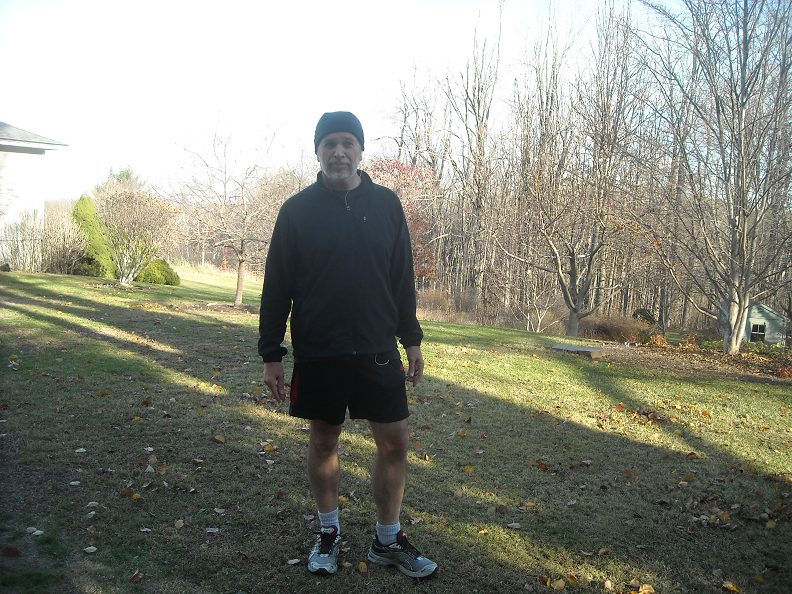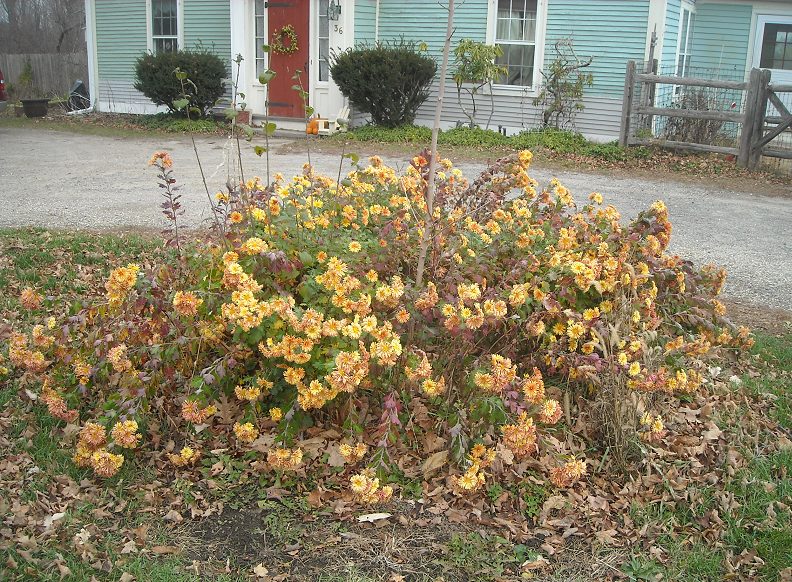Hello folks,
We all like to talk about the weather, or complain about it, particularly as it pertains to our gardening efforts. And, because forumists are located throughout North America and the World, it is interesting to witness the climatic differences and challenges that each gardener faces, no matter where located.
Recently we've seen photos posted by forumist Lori Skulski in Alberta, Canada; very wintry scenes showing lots of snow. By comparison, in Northeastern USA, we've had one of those endless autumns; sure, a few night down into the mid 20s F (-4 C) but typically warming up by midday. Today, it was 62 F (16 C), and I went for a 5-mile run in short-sleeve shirt it was so warm. I would prefer generally colder temperatures to continue acclimatizing plants for the oncoming winter, although I'll gladly accept an occasional extra mild day here and there before the full onset of winter.
I uploaded a few photos, the first is me after a run a couple days ago, one of the few cold sunny days that reached just above the freezing point by early afternoon; man I love the cool weather. Followed by two photos of a neighbor's super-late-flowering Chrysanthemum, one that doesn't start flowering until November, undeterred by frosts, with lots of orange-yellow blooms (photos 2-3). I must ask my neighbor for a piece; the "mum" has been a stalwart last-bloomer in her garden for the 22 years that I've been here. And photo 4, shows a view of my garden from the street... as I run a 1.25 mile loop around the neighborhood, I do visual botanizing and garden assessment while running; I like the look of the slow-burn of fall color on my epimedium plants as I run by repeatedly.





Comments
Lori S. (not verified)
Re: Weather 2010
Tue, 11/23/2010 - 7:50pmGood topic!
Let me be the first to
bellyachecomment... It was a bracing -31 deg C this morning, and warming through the day to a balmy -26 deg C... ah, yes, practically shirt-sleeve weather too for us hardy northerners. :rolleyes:Mark McDonough
Re: Weather 2010
Tue, 11/23/2010 - 8:04pmHoly Moly Lori, that's CRAZY Cold!
First of all, for the life of me, I can never ever equate Fahrenheit with Celsius, as much as I've tried over the years. Metric measurements I'm good with, but Celsius baffles me, and probably most Americans. So, here's a link to one of many handy-dandy Fahrenheit-to-Celsius conversion web sites:
http://fahrenheittocelsius.com/
Let me translate those temps for us Americans, -31 C in the morning is -23.8 F, and the daytime temp of -26 C is -14.8 F. Thankfully, you do have snow cover, to protect your plants given that extreme cold.
Lori, aren't you glad Hugh fixed the previously non-functioning roll-eyes emoticon; an essential technological feature of the forum ;D
As a side note, hearing from others around the globe, might give some perspective on your own climate. Thanks Lori! Hope your weather moderates some.
rsneha rani (not verified)
Mark McD wrote:
Wed, 01/30/2019 - 1:18am[quote=Mark McD]
First of all, for the life of me, I can never ever equate Fahrenheit with Celsius, as much as I've tried over the years. Metric measurements I'm good with, but Celsius baffles me, and probably most Americans. So, here's a link to one of many handy-dandy Fahrenheit-to-Celsius conversion web sites:
http://fahrenheittocelsius.com/
[/quote]
Thanks or you can also try this Fahrenheit to Celsius converter.
Lori S. (not verified)
Re: Weather 2010
Tue, 11/23/2010 - 9:06pmWell, at least we were only the second coldest place on earth today... Apparently, that honour went to the Amundsen-Scott South Pole Station in Antarctica, where it was -36 F (or -38 C)... yes, the "rolling eyes" emoticon is indispensible at times like this!
http://www.calgaryherald.com/technology/Calgary+coldest+place+Earth+Weat...
It felt darned uncomfortable, walking to and from the train and out for a meeting today... made me wonder how I survived winters growing up in Saskatchewan, where it was really cold.
Richard T. Rodich
Re: Weather 2010
Tue, 11/23/2010 - 11:07pmWow Lori, that's hard to imagine for me, too, so early in the season. And Mark, metric/english temperature conversions have always been harder for me too, compare to lengths.
For anyone with an old computer with a small processing chip, here is a tiny sized (166kb) and very fast metric conversion calculator that you can download to you computer for easy, quick access. No need to bring up a page on the internet, or even be connected.
http://www.download3k.com/Business-Finance/Calculators-Converters/Downlo...
Trond Hoy
Re: Weather 2010
Wed, 11/24/2010 - 6:01amAlthough I prefere the Celsius scale, I have no dificulties with Fahrenheit! You start with the freezing point of water (0C/32F) and the boiling point (100C / 212F). Then you get these easy equations:
C=(F-32)*5/9 and F= 9*C/5+32
But I wonder, US was one of the first nations to sign the metre convention in 1875 and you have not starting using it yet!?
Trond Hoy
Re: Weather 2010
Wed, 11/24/2010 - 9:17amYes, the weather is always something to talk about.
Here we have had the first day without temperatures above the freezing point. This morning it was -5C/23F here and -10C/14F along the road a mile further inland. This is exceptionally cold for the season here. The eastern and northern parts of Norway experience even colder weather - down to -30C/-22F - not much warmer than Calgary!
The weather is very quiet, clear and cold. The sun rises about 5AM and sets about 6PM but the low sun don't bring any warmth. And worse, I have no snowcover! The weather forecast says we will have the same for at least 10 days still.
I like cool weather but not this, not here.
Richard T. Rodich
Re: Weather 2010
Wed, 11/24/2010 - 9:47amWhen I was in High School back in the mid 1970's, that was the last real push for the change to the metric system in the U.S. Compared to back then, the metric system is second nature to me now (I just have to stop and think about temperature first), but I was very hopeful, back in the 70's, that the change would stick. Alas, it did not.
Trond Hoy
Re: Weather 2010
Wed, 11/24/2010 - 12:17pmOK, it is understandable not to change now, but why not then!
By the way, here's the weather in northern Norway today: http://vimeo.com/16917950
Mark McDonough
Re: Weather 2010
Wed, 11/24/2010 - 8:10pmArtistic video, the aurora borealis is really something to see.
Worked for a couple hours outside today cutting down perennials. It was 39 F (4 C), and even though I wore heavy winter garb, the wind was roaring and had the effect of drawing away any body warmth, I was freezing and my hands started aching.
Mark McDonough
Re: Weather 2010
Wed, 11/24/2010 - 9:16pmMy weather forecast is looking colder, with some freezing rain. Freezing rain is the one winter condition that I worry about the most; particularly after the ice storm of December 2008, with devastating damage and being without power for about a week, some areas 2 weeks.
Trond Hoy
Re: Weather 2010
Thu, 11/25/2010 - 4:04amAnything but freezing rain! Makes it impossible to drive in a decent way.....
What kind of tyres do you use in winter?
Peter George
Re: Weather 2010
Thu, 11/25/2010 - 7:09pmIn New England, everyone drives all wheel drive cars with 4 season tread, so we rarely have problems. Since I moved to Massachusetts in 1978 there have only been 3 years when I wasn't driving a 4 wheel drive/all wheel drive vehicle. When I first got here I used to put on snow tires around this time, but I discovered that the new all season radials work just as well and I don't have to bother changing them over twice a year.
Richard T. Rodich
Re: Weather 2010
Thu, 11/25/2010 - 9:39pmPeople in Minnesota drive all wheel drive vehicles here too, but that doesn't seem to keep them from going in the ditch. They don't seem to realize that all wheel drive only gives them better traction to get going; it hardly keeps them on the road any better, and there isn't any advantage for stopping, either. I don't want to afford a 4 wheel drive: I have a rear wheel drive, small Toyota pick up truck, and I do just fine.
Trond Hoy
Re: Weather 2010
Fri, 11/26/2010 - 12:10amNow I use unstudded winter tyres but most people use studded tyres in winter. The unstudded tyres are composed of a softer rubber mix and are really good in winter, however, the studded ones are better on ice.
I change twice a year (1/2 hour work) and use special summer tyres in summer. They are build of harder rubber mix, the winter tyres are too soft in summer.
A lot of peoples here use 4 wheel drive but I have an ordinary front wheel drive (Kia ceed). No problems last winter!
Woodard (not verified)
Re: Weather 2010
Tue, 11/30/2010 - 4:33pmIn my climate (Nashville, TN, though these comments are applicable throughout much of the eastern US), the most challenging thing is drought. However, this can be dealt with fairly easily given our current water resources (the city, to my knowledge, has hardly ever had to place restrictions on usage, so if one can afford the bill or is willing to pay it, all is not lost). The water issue is compounded locally by the fact I garden on a dry wooded ridge. Over the years I have removed all maples near the garden, but even the deep-rooted oaks and hickories can draw large amounts of moisture from the surface, so any soil moisture from say a 1-inch rain in a time of drought quickly disappears. Second is warm night temperatures. At even modestly higher elevations and at even slightly higher latitudes, the plants receive a break from summer heat after sunset and before sunrise. Here that's not usually the case. Third, there are wild fluctuations in temperature, particularly in winter. This mainly affects plants that are winter-active and those that emerge very early in spring. As a hellebore enthusiast, this is not ideal as it can lead to crop failure (little or no seed) from prized plants in some years, and I have some eager bloomers that have their reproductive parts destroyed almost annually.
In terms of recent weather, autumn has been very warm, and until recently, very dry. There was a period of 70 days from late August to early November in which there was virtually no rain. I heard through a friend that a man who works with a backhoe said that the ground was completely dry even when excavating, something that he had not recalled seeing before. So far we have had a handful of freezing nights in which the air temperature dipped into the mid-20s, but I have seen even tender annual seedlings (S. coccinea, for instance) emerging from newly-composted areas, so at ground level the temps have not yet reached freezing. Also, violent weather phenomena have increased dramatically in recent years. A couple of decades ago, tornadoes were somewhat of a rare event. They have become increasingly common in the area as the warm seasons have grown longer and longer.